OPOD - Moiré Patterns & Fringes
OPOD - Moiré Patterns & Fringes: Unveiling the Enigmatic Optical Phenomenon
Have you ever noticed ethereal shapes and tessellations flickering before your eyes with the slightest movement? Perhaps you've been captivated by the mesmerizing fringes on fabrics or the distracting flashing false colors on a TV announcer's check jacket. These intriguing visual phenomena are known as moiré patterns and fringes.
Moiré patterns and fringes manifest in various forms, from curved and shimmering fringes on fabrics to lines and artifacts when scanning printed pages. They can even appear in unexpected places, like a pair of overlapping doors at the entrance of a mall. Such was the case when Mario Freitas of Universidade Tecnológica Federal do Paraná encountered a hexagonal moiré pattern on these doors in Curtiba, Brazil.
These captivating patterns are created by the interplay of light rays passing through or being blocked by screens or masks with specific geometric patterns. In the case of the mall doors, each door had a screen composed of a hexagonal array of circular holes, approximately 2mm in diameter. The screens were positioned about 50mm apart, allowing for the formation of intricate moiré patterns.
As Mario approached the doors, something unexpected happened. Instead of the hexagonal pattern appearing larger as he got closer, it actually became smaller. This phenomenon can be observed in the smaller images labeled a and b. Upon closer inspection (image c), the moiré pattern seemed to dissolve into the design of the screen itself. And at an even closer distance (image d), the hexagonal hole array of the nearer screen became visible.
What our eyes or cameras perceive is a mosaic of the distant scene, with the two screens acting as masks that selectively reveal or block certain elements. When a line from a scene or background aligns with a hole in each screen, it becomes visible. Conversely, angular directions where the holes do not align at all result in the blocking of light, creating dark areas. This periodic alignment or transmission of light through the screens gives rise to the formation of moiré patterns.
To better understand how moiré patterns form, let's consider a simpler scenario involving linear arrays of holes. When two screens with such arrays are positioned close to each other, the conditions for alignment or transmission occur periodically. As a result, a moiré pattern emerges. It's important to note that the generation of moiré patterns is highly sensitive to movement. Even the slightest shift in position can dramatically alter the pattern observed.
The sensitivity of moiré patterns to movement is not only fascinating but also finds practical applications. For instance, this property is utilized in rotation and position sensors, where changes in the moiré pattern can be used to detect and measure movements accurately.
As we delve deeper into the mechanics of moiré patterns, we discover that their formation is closely tied to the spacing between holes in the screens. As an observer moves closer to the screens, the spacing between aligned holes decreases, causing the moiré pattern to shrink. This phenomenon can be observed in what is known as a one-dimensional moiré pattern.
To create moiré patterns intentionally, one can employ various techniques. For example, a pattern containing transparent holes or spaces can be designed and saved as a layer in image editing software like Photoshop. By duplicating and manipulating this layer—enlarging, reducing, rotating, or distorting it—one can generate intricate moiré patterns with captivating visual effects.
It's worth noting that moiré patterns can also be generated using regular repeating grids. In such cases, the resulting moiré patterns are an enlarged version of the underlying grid. Interestingly, the shape of the holes in the grid is less important; even a rectangular array of rabbits can produce a rectangular moiré pattern with just a hint of the original rabbit shape.
The phenomenon of moiré patterns is closely related to optical interference, where two sets of light waves superpose and interfere with each other. When the masks or screens in a moiré pattern are regularly spaced lines or circles, they replicate the positions (though not the intensities) of interference fringes that occur when coherent light interacts with two slits.
Moreover, when arrays of distorted lines are used as masks, the resulting moiré fringes often exhibit twisting and curved patterns, which are commonly observed on fabrics.
Moiré patterns and fringes are captivating optical phenomena that offer a glimpse into the complex interplay of light and geometric patterns. Whether they appear on doors, fabrics, or even TV screens, these patterns continue to intrigue and inspire us with their ethereal beauty. So next time you encounter a moiré pattern, take a moment to appreciate the delicate dance of light and form that gives rise to this enigmatic visual spectacle.
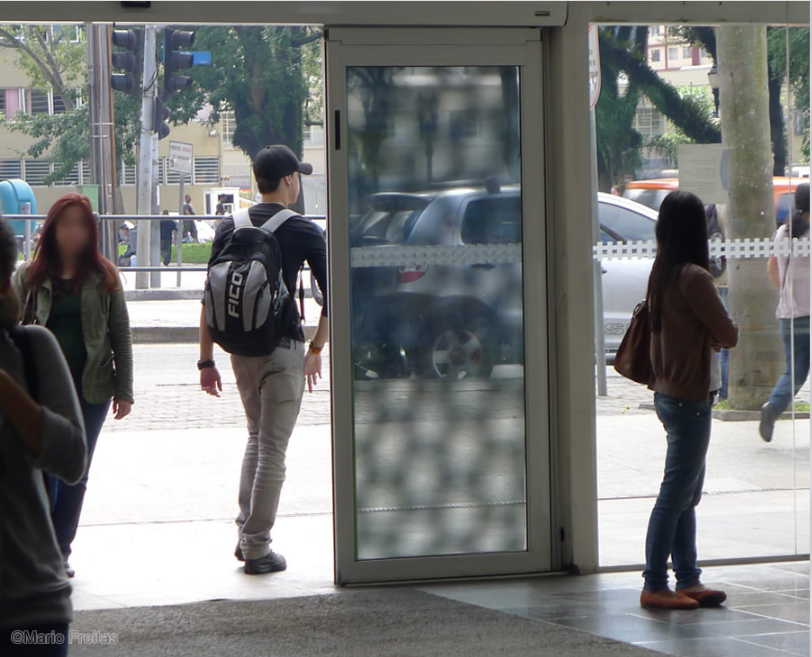
Moir� Patterns & Fringes
Ethereal shapes, tessellations darting and flickering with the slightest head movement.
Curved and shimmering fringes on fabrics, distracting flashing false colours on a TV announcer's check jacket, lines and artifacts when scanning printed pages - all manifestations of moir� patterns and fringes.
Mario Freitas of Universidade Tecnológica Federal do Paraná saw this hexagonal moiré pattern on a pair of overlapping doors at the entrance of a mall in Curtiba, Brazil.
Each door had a near identical screen made up of an hexagonal array of circular holes ~2mm diameter. The screens were ~50mm apart.
Light rays passing through, or being blocked by, the screens made the patterns.

The top image was taken with a zoom lens some distance away.
As Mario then approached the doors (smaller images a and b) the hexagonal pattern surprisingly got smaller rather than larger as might at first have been expected.
Close up (c) the ever smaller moiré pattern dissolved into the screen design itself. Really close (d) we see the nearer screen's hexagonal hole array.
What the eye or camera sees is a mosaic of the distant scene. The two screens act as masks that in places open to reveal the scene and in other places block it.
An element of the scene or background is visible when a line from it to the eye can pass through a hole in each screen. Angular directions where the holes do not align at all have light blocked and appear dark.
The conditions for alignment or transmission occur periodically with the result that a moiré pattern forms. The pattern generation is most easily visualised for a pair of simple linear arrays of holes as at left.
The condition of transmission through a given pair of holes in the two screens is extremely sensitive to the position of the eye or camera. The slightest movement shifts the pattern dramatically.
Moir� patterns are generally are very sensitive to movement, a property used in some rotation and position sensors.
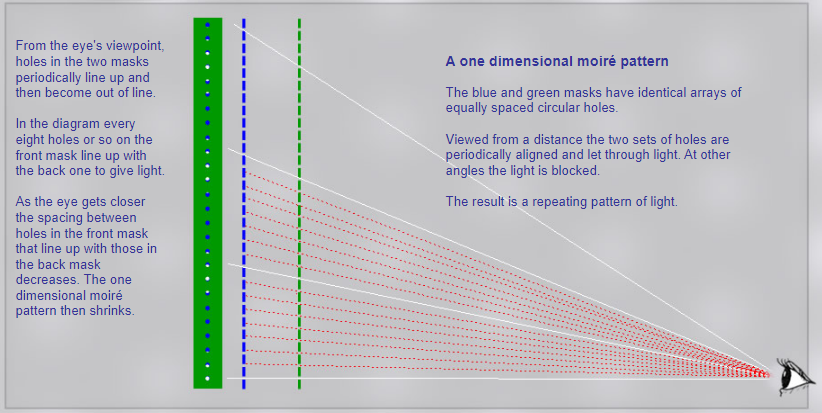
From the eye's viewpoint, holes in the two masks periodically line up and then become out of line.
In the diagram every eight holes or so on the front mask line up with the back one to give light.
As the eye gets closer the spacing between holes in the front mask that line up with those in the back mask decreases. The one dimensional moiré pattern then shrinks.
A one dimensional moiré pattern
The blue and green masks have identical arrays of equally spaced circular holes.
Viewed from a distance the two sets of holes are periodically aligned and let through light. At other angles the light is blocked.
The result is a repeating pattern of light
Create moir� patterns
Make a pattern containing transparent holes or spaces. Save the pattern as a layer in Photoshop or equivalent.
Alternatively, download this PSD file example.
Duplicate the layer.
Enlarge, reduce, rotate or distort the top layer to generate moiré patterns.
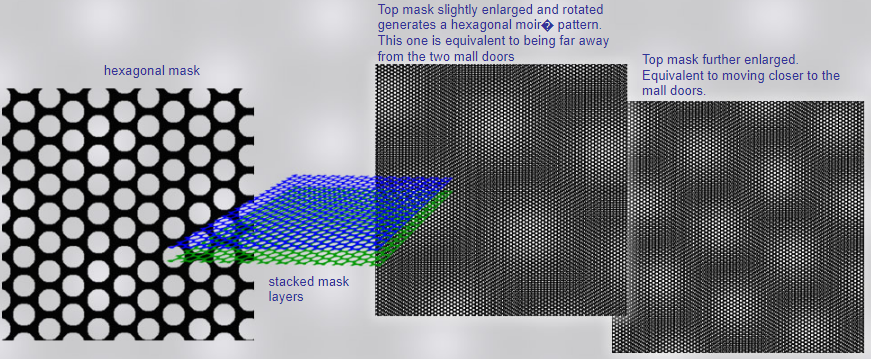
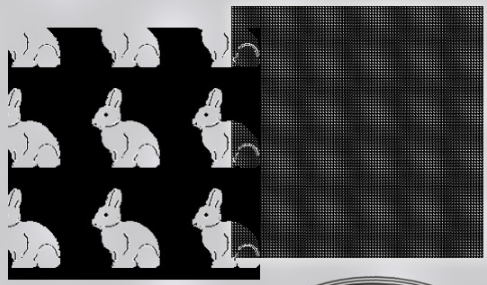
Regular repeating grids produce moir� patterns that are a highly enlarged version of the grid.
The hole shape is less important. This rectangular array of rabbits gives a rectangular moiré pattern with only a hint of rabbit.
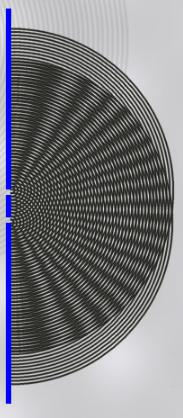
Moiré and interference
Moiré patterns are the result of two masks that let through light when their apertures overlap and block it otherwise.
When the masks are regularly spaced lines or circles the effect is akin to optical interference where two sets of light waves superpose and interfere. There is light in directions where wave crests (lines) coincide and darkness where they are out of phase.
At right, two overlapping masks of equally spaced circles reproduce the positions (but not intensities) of interference fringes generated when a coherent light beam impinges on two slits.
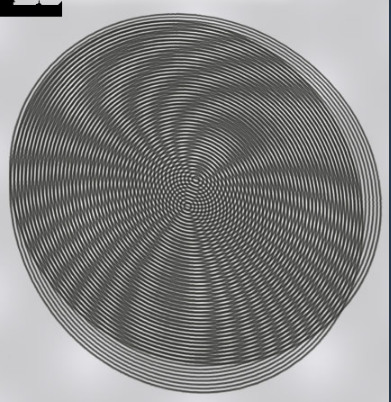
Masks where arrays of lines are distorted give the twisting and curved moiré fringes often seen on fabrics.
Note: this article has been automatically converted from the old site and may not appear as intended. You can find the original article here.
Reference Atmospheric Optics
If you use any of the definitions, information, or data presented on Atmospheric Optics, please copy the link or reference below to properly credit us as the reference source. Thank you!
-
<a href="https://atoptics.co.uk/blog/opod-moir-patterns-fringes/">OPOD - Moiré Patterns & Fringes</a>
-
"OPOD - Moiré Patterns & Fringes". Atmospheric Optics. Accessed on November 26, 2024. https://atoptics.co.uk/blog/opod-moir-patterns-fringes/.
-
"OPOD - Moiré Patterns & Fringes". Atmospheric Optics, https://atoptics.co.uk/blog/opod-moir-patterns-fringes/. Accessed 26 November, 2024
-
OPOD - Moiré Patterns & Fringes. Atmospheric Optics. Retrieved from https://atoptics.co.uk/blog/opod-moir-patterns-fringes/.